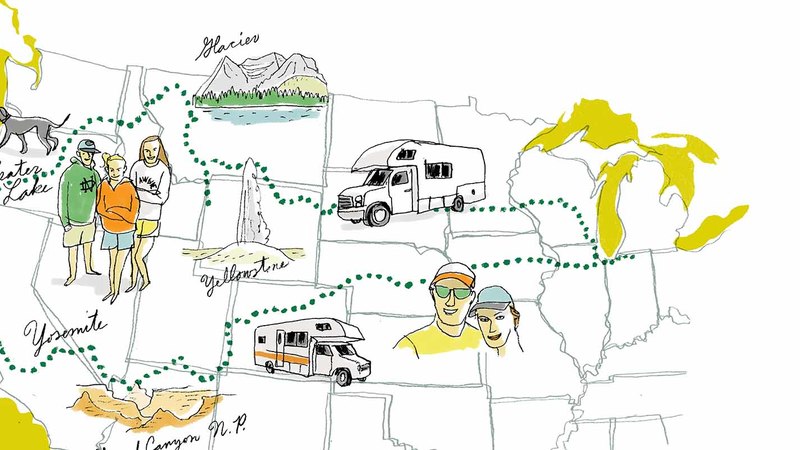Pulling out of the overcrowded parking lot at Mount Rushmore, I backed up our rented recreational vehicle for the first time. My wife, Laurel, stood outside yelling guidance like a flag-waver at the airport. Everything was fine until I pulled forward and right, not accounting for how widely a 28-foot motorhome swings when you turn.
Crunch.
I’d caught the back corner of the RV parked in the spot to our left, scraping its side panel, breaking a turn light and bending its rolled-up awning.
It was only the second day of an epic three-week family road trip to America’s western national parks, and I’d already dented our home and transportation. I’d later learn that the three gouges in my rental would cost nearly $7,000 to repair. Just hours earlier, it had been going so well.
We had gazed out through a notch in the sandstone cliffs of the Badlands over a valley of green and yellow grass bisected by the appropriately named White River. To get there, we had scrambled up a 100-foot log ladder, edged along a modest cliff my younger daughter called “the most dangerous thing I’ve ever done” and walked a mile through a colorful playground of eroding hills in South Dakota.
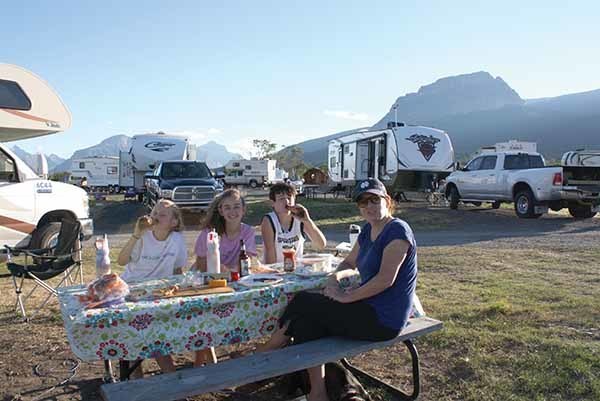
I had hoped there would be a herd of buffalo grazing below, but it was still spectacular. And now my kids — Maeve, 14; John, 12; and Kate, 9 — actually wanted to hear their old man tell a story about the river and the first European explorers. I know, shocking.
“Imagine having to cross through this place on horses before there were any roads,” I said. “The leader’s name was Jedediah Smith, a famous mountain man. They ran out of water and were so thirsty they drank from the White River.”
We looked down on the river, murky with the silt and clay melting from the Badlands with every rain.
“The water made them even sicker, and two of the men were too dehydrated to go on. So Jedediah buried them up to their necks in the sand to preserve what hydration they had, then rode off to find clean water. Imagine being unable to move, watching the horses ride away. That’s how much faith they had in Jedediah. He came back the next day with clean water, dug them out and saved their lives.”
I hadn’t intended Jedediah’s mishap and redemption adventure to be a metaphor.
The seed for this trip took root when my kids chose driving to a Florida beach over a ski trip to Colorado. It occurred to me they had never seen a real mountain, only some ski hills in Michigan. Sure, we live in the Midwest, but it’s clearly my fault. And I had only a short window to remedy the problem. My oldest was about to enter high school, with all its demands on time, from social life to summer jobs. This was our last chance.
In my head, I imagined a grand U.S. tour, sampling the beauty of our country like John Steinbeck’s last book, Travels with Charley. Steinbeck explains the travel bug this way: “Four hoarse blasts of a ship’s whistle still raise the hair on my neck and set my feet to tapping. The sound of a jet, an engine warming up, even the clopping of shod hooves on pavement brings on the ancient shudder, the dry mouth and vacant eye, the hot palms and the churn of stomach high up under the rib cage. . . . When the virus of restlessness begins to take possession of a wayward man, the road away from Here seems broad and straight and sweet.”
- Hitch a Ride with the O’Shaughnessys
- Westward Ho
Yet I knew it could easily turn out a lot more like the Griswold family misadventure in National Lampoon’s Vacation: “Sorry folks, park’s closed. Moose out front shoulda told ya.”
Along the way, I hoped to inspire my kids to a lifelong love of the outdoors in just three weeks’ time. No pressure there. I also hoped to rekindle in myself the adventurous spirit that was once central to my worldview but had since faded into the reality of work and raising kids and middle-aged ennui. I once took insane bus trips across Central America, quit jobs every two weeks in Santa Fe so I could camp the rest of the month, and led drug addicts on three-week backcountry trips in Montana. One year, I spent more nights in a tent than in a bed. Now I take the kids once a year to a Lake Michigan parking lot that calls itself a campground.
The plan was to load the family — mom, dad, three kids and a dog — into an RV and drive a 6,800-mile loop out West. Laurel is more the spa type than the tent type, so the RV, which I once would have disdained, was our compromise. It would cost more than $2,000 for gas alone. We’d visit the Badlands, Yellowstone, Grand Teton, Glacier, Crater Lake, Redwood, Yosemite, Zion and the Grand Canyon, with other stops planned and unplanned. It would be equal parts Steinbeck grandeur, spiritual rejuvenation and family fiasco.
Along the way, I would face a few truths. One is that you can’t relive your youth or re-create the experiences that made you love the simple joys of the outdoors. Each person must get there on their own. Second, there is such a thing as an overload of beauty and awe. Lastly, kids will poke each other relentlessly no matter how large the vehicle.
First taste of the West
I was not prepared for the Bad Lands. . . . Such a place the Fallen Angels might have built as a spite to Heaven, dry and sharp, desolate and dangerous, and for me it was filled with foreboding. . . . And then the late afternoon changed everything. As the sun angled, the buttes and coulees, the cliffs and sculptured hills and ravines lost their burned and dreadful look and glowed with yellow and rich browns and a hundred variations of red and silver gray, all picked out by streaks of coal black. . . . I was caught, trapped in color and dazzled by the clarity of the light.
— John Steinbeck, Travels with Charley
I started planning the trip the previous summer on the Roadtrippers website. I made the first reservation for a recreational vehicle I hadn’t yet rented in October, deciding to make detailed plans for the crowded areas of the first and third weeks but wander blind and free in the second week. I assigned each kid two parks to research and pick what to do there. How lucky that this summer was the 100th anniversary of the U.S. national parks system, the incredibly democratic idea that the country’s best places should be public. To celebrate, the parks made admission free for any family with a fourth grader — and I happen to have one of those.
I knew nothing about RVs so I borrowed a friend’s copy of RV Vacations for Dummies. At pickup, the company’s rental manager buzzed through the vehicle instructions — hook up water here, press this button for the generator, this one for nuclear self-destruct — in half an hour, leaving me overwhelmed. I wanted to call this contraption Rocinante, which Steinbeck named his retrofitted pickup truck in honor of Don Quixote’s horse, but that turned out about as well as my pitch to name our dog after Huckleberry Finn instead of Abby. Kids just don’t appreciate literary allusions these days.
We left at 4 a.m. on July 17, driving straight through 15 hours to our campground outside the Badlands in South Dakota. Immediate panic ensued because we couldn’t get the air conditioning on or the water hooked up. A friendly parking space neighbor explained that we just needed to flip the power switch and turn the hose around to the other end. Such a rookie.
Some parts of every road trip blur into barely connected images: pronghorn antelope, bighorn sheep, barking prairie dogs. No dogs allowed on the trails. Kids amped up to photograph the wildlife. The Badlands are perfect in scale — big enough to impress but not overshadow what’s to come.
John had been hesitant to spend three weeks on this trip, missing out on summer days spent in airsoft gun battles with his neighborhood friends. Yet climbing sandstone cliffs and jumping across small ravines convinced him that “this trip is going to be awesome.” Maeve, more stoic than her little brother, sometimes gave the impression that she would rather text her friends. She did jump out of the RV to chase a bighorn sheep down the road and snap smartphone pictures, but she still needed convincing. Kate, the organized miniversion of her mother, created a list of new animals they encountered. She wanted to see a buffalo.
The tourist trap town outside Mount Rushmore should have been a harbinger of my driving accident a few hours later. I let the kids convince me to take them on an alpine slide, a kind of toboggan run down a mountain in rolling sleds with brakes that John considered optional. He flew off his sled and scraped the skin off his elbows. Sometimes, the best thing about having kids is the excuse to go on these kinds of rides and to Pixar movies that make me cry.
The next morning, we drove our now-dented RV through Custer State Park, a beautiful range of high grassland meadows and hills in South Dakota. Besides rehashing the story of Custer’s Last Stand, our main purpose was to see the herds of buffalo there.
Not one hairy beast in sight. At least 37 times, I heard: “Dad, do you think we’ll ever see a buffalo?”
At least Yellowstone doesn’t disappoint. As we approached the park’s east entrance that evening, a single buffalo trudged along the side of the road. After taking our obligatory picture of the park sign, we had to hustle back into the RV as the buffalo passed a few feet away, to my double relief.
Big mountains, big sky
I am in love with Montana. . . . It seems to me that Montana is a great splash of grandeur. The scale is huge but not overpowering. The land is rich with grass and color, and the mountains are the kind I would create if mountains were ever put on my agenda.
— John Steinbeck, Travels with Charley
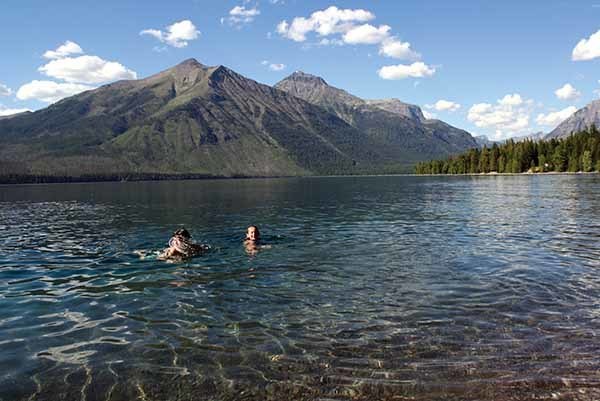
For most of the 19th century, Yellowstone was considered another example of the western tall tale. Protected within a ring of high mountains, the reports of early trappers and mountain men were dismissed as poetic visions of Xanadu with hellish fringes.
Warned that the expedition was suicide, Charles W. Cook and two other adventurers set out from Montana in 1869. Cook sent his description of the region’s marvels — catch a fish in the huge lake and swing your pole around to cook it in boiling springs! — to Lippincott’s Magazine. The report was returned with a note: “Thank you but we do not print fiction.”
It took a second expedition the following year, this time by prominent Montana Territory business and government leaders, before people believed. According to legend, the landscape so inspired the group that the first discussion of “a people’s park” happened around a campfire at the confluence of the Gibbon and Firehole rivers.
This was the era of the rapacious robber barons, timber moguls and westward homesteaders pushing to tame and exploit the wilderness. Yet a radically different sentiment from that period still lingered — the Romantic movement of Ralph Waldo Emerson and Henry David Thoreau. The idea that Nature, immense and sublime, represented the design and artwork of God was not a stretch for those early explorers overwhelmed by Yellowstone’s geysers and sulfur springs.
These pioneers pushed Yellowstone to become the world’s first national park. President Ulysses Grant signed the law in 1872. It was a uniquely American concept to set aside land not for kings or nobles, but for everyone, forever.
My kids, they really loved the buffalo traffic jams. Finally, so many buffalo that they clogged the road and dotted the meadows and crowded the hot springs and mud pots. Their presence stirs a mixed symbolism: both the mythic nostalgia of Indians riding bareback with bows and arrows, and the horror of mountains of skulls left by white hunters shooting rifles from moving trains.
The park’s wonders whiz by: Artist Point, yellow rock gorge and the 308-foot Yellowstone Lower Falls. So amazing that Maeve said her picture of Kate looked like a Photoshop fake. Dragon’s Mouth hot spring bellowing smoke from a cave. Grazing elk. The psychedelic colors of Grand Prismatic Spring. Another buffalo jam, idle time. Hungry kids, Laurel throwing food out of cabinets onto the floor, everyone averting eyes. Squabbling kids, me ready to blow up like Old Faithful.
There’s so much to see in Yellowstone it’s like a dozen parks in one. Just to the south, the Grand Tetons are all about the incredible view. What makes the Tetons grand isn’t just their height but the jagged raw beauty of peaks thrusting 7,000 feet without any foothills to soften their power. We got our first hotel room to get out of the RV, and it was glorious. Maeve even admitted that our white water raft trip down the Snake River beat sleeping in to teenager time. Her face lit up in fear and delight as we plunged into a massive hydraulic wave known as Big Kahuna. We somersaulted out of the boat into the freezing water during a calm stretch.
A week into the trip, we arrived in Bozeman, Montana, to see my first childhood friend. Bill Fanning is a purist in every way. If he makes coffee, it has to be kickass espresso. If he cooks eggs, it has to be in a cast-iron skillet. If there’s a mountain, it must be climbed, and with only a crust of bread tied to a belt loop. When he quit his job to home-school his three young boys for a few years, he would take them cross-country skiing mornings and mountain biking afternoons. In my mind, I picture him leading feral children in loincloths bow hunting along mountain ridges.
He suggested we hike up about six miles to a high alpine lake to fish. I tried to imagine my 9-year-old trekking a dozen miles and talked him into a new plan: fishing and boating on a nearby reservoir. Surrounded by mountains punctuated by lodgepole pines, we relaxed and watched Abby run wild with Bill’s two dogs. The six kids fished and swam and heaped scavenged wood on a huge bonfire. Bill’s equally hardcore wife, Kristi, taught Laurel that trails are optional. “It’s called bushwacking,” she yelled through a dense clump of alder.
Bill has an innocent talent for making you realize just how soft you’ve become. Laundry done, it was time to go.
Glacier Park blurs images past and present: age 25, a summer at the Wilderness Treatment Center, a rehab for drug-addicted teens, backcountry camping. Sublime views, snowball fighting in July, the engineering wonder called the Going-to-the-Sun Road. An immediate bear sighting, Kate entering it on her list. Mountain goats cross our trail to Hidden Lake. Swimming in Lake McDonald with a backdrop screaming to quit your job, buy a Volkswagen van and live there forever.
Entering Kalispell, I made straight for Moose’s Saloon, the favorite pizza joint for the employees at the treatment center. The déjà vu was powerful — the interior shrouded in darkness, animal heads on the walls, sawdust on the floor, a beer called Moose Drool for cheap. Twenty years ago, it had a funky French horn that curled around and opened back toward the musician. Tourists were told that if they covered the right three holes out of six, it would sound a moose call and they would get a free beer. Instead, baby powder would explode from the horn into their face. Bar regulars would play it cool but break into raucous cheers for each sucker, who did get a free beer.
Naturally, I couldn’t wait to play the trick on my son. But not everything can remain frozen in time. The bartender said a patron didn’t take kindly to the prank a few years back, so they had to ditch the horn when he threatened to sue.
For the first time all trip, we didn’t have a campground reservation. One of the advantages of the RV is that you can let serendipity find the hidden gems. The Symes Hotel, as the neon sign proclaimed, in Hot Springs, Montana, was not what I had in mind.
The hotel opened in 1930, when the idea of a hot bath at a mineral spring must have been quite a treat. Nothing appears to have changed since. Unlike Moose’s, this wasn’t positive.
One side of the hotel featured the pools, enclosed in chain-link fences and smelling like sulfur. The other side had a long open carport with rusting farm equipment and a few dusty automobiles too ancient even for Cuba. Inside, a row of discolored bathtubs lined one hallway, each in its own wooden horse stall. One tub had a rope above it — possibly to hang yourself in the horror movie that should be filmed there.
Shauna, the desk clerk, charged $48.15 to park in the grass yard. The water hookup lacked pressure and the electricity hookup popped a fuse within an hour. We might as well have stopped on the side of the road.
“Our spring water has the second highest concentration of minerals in the world,” Shauna said. “One hundred seventy-five minerals. People come for healing from all over.”
Terrifying, I think. John, who took a quick swim in the pool, turned to me: “Actually, I do feel pretty good.”
Among the trees and fog
The redwoods, once seen, leave a mark or create a vision that stays with you always. No one has ever successfully painted or photographed a redwood tree. The feeling they produce is not transferable. From them comes silence and awe. It’s not only their unbelievable stature, nor the color which seems to shift and vary under your eyes, no, they are not like trees we know, they are ambassadors from another time.
— John Steinbeck, Travels with Charley
Driving a 28-foot vehicle on a road that has suddenly become dark, twisty and saturated in fog is terrifying enough. Then a black mass the size of a skyscraper jutted out six inches into the right shoulder of the road. More followed, like swerving through giant aliens in a video game.
We had reached a redwood forest on the California coast. Despite GPS and a map, I couldn’t find a campsite in the redwood grove where I hoped to stop. We kept going until we could smell the salt air of the Pacific Ocean, crashing in a cheap motel.
Along the drive, we’d jumped off cliffs in Coeur D’Alene, Idaho, and gazed briefly over the iridescent blue waters of Crater Lake, nestled in a volcanic cone in Oregon. We’d finally made it to the other coast, so the kids did handstands, jumps and dab dance moves on the beach. Think foggy cold and battleship gray water, not sunny Florida.
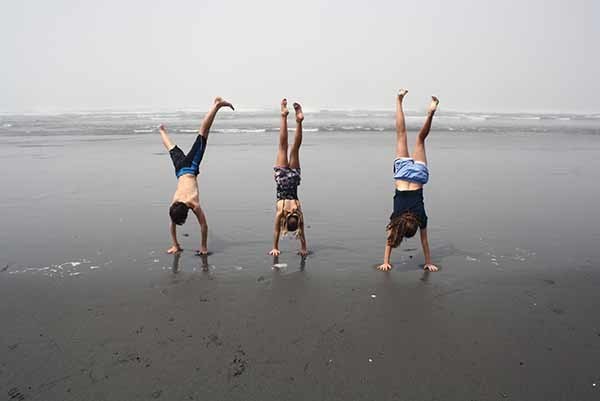
My first foray in the redwoods stands out from the other places, where I was revisiting the parks through my kids’ eyes. Often 300 feet high, the coastal redwoods form a celestial canopy in groves that stretch for 500 miles from Big Sur south of San Francisco to just over the Oregon border. They range from five to 35 miles inland, taking the bulk of their moisture not from shallow roots but from the fingers of fog creeping off the ocean. They are able to withstand fire and disease thanks to their foot-thick bark, lack of flammable pitch and bug-resistant tannins. Which explains how some sequoias have been around since before Christ was born. Since Aeneas left Troy. Since Moses fled Egypt.
Their immense size and history could convert an atheist into a believer, or at least a spiritual seeker. Only a narcissist wouldn’t ponder about how small and brief life is. How should we respond? Abby, the kids and I walked along fallen trees that formed 15-foot-high bridges spider webbing the eerily silent forest floor. Laurel, a big fan of nice hotels, said, “I could camp here for a while.”
We drove through Napa Valley’s wineries to Carmel, California, where we would visit a friend with whom I taught high school in Chicago two decades ago. David Schmittgens now chairs the English department at a swanky private school located on the famous Pebble Beach golf course, where housing is so costly that the school provides it to teachers. Like Bill, Dave welcomed this monstrous vehicle and the circus inside it with hospitality and humor. He and his twin boys took us to see tide pools, sea lions and an aquarium in Monterrey, Steinbeck’s old stomping grounds.
As the calendar turned to August, we set off to see Yosemite, pronounced Yose-might by the kids. On March 15 at 10 a.m., the park service had made hundreds of campsites available for a month-long period that summer. I had been ready at my computer, but the online melee is so competitive I barely got a spot, and all were gone within three minutes. It’s easy to see why as you enter the valley, enclosed on both sides by towering granite cliffs.
John Muir, the founding father of conservation and spiritual muse of the national parks, called the Sierra Nevada Mountains the “Range of Light” and Yosemite Valley its “sanctum sanctorum.” Muir was such a rabid adventurer he once climbed a 100-foot fir tree in a raging windstorm to ride its top whipping back and forth like a carnival ride. He camped for three nights with President Theodore Roosevelt and converted the renowned hunter into a conservationist. After waking in this valley one morning and dusting snow off his blankets, Roosevelt judged it the “finest day” of his life and led the park system’s expansion.
Healed himself by nature, Muir wrote “John [the] Baptist was not more eager to get all his fellow sinners into the Jordan than I to baptize all of mine in the beauty of God’s mountains.”
My family found wonder but also exhaustion. We hiked the Mist Trail to Vernal Fall, up paths crowded, like most of the parks, with more German and Asian tourists than Americans. After gaining 1,000 feet in elevation, Laurel and the kids opted to turn for home, while I kept going to the top of Nevada Fall. As I returned on the seven-mile loop, I found myself alone on the John Muir Trail with a view overlooking the roaring falls and Half Dome, a granite goliath favored by mountain climbers. I could hear at least the echo of youthful exuberance.
Recent scientific research confirms what Muir and Emerson knew intuitively: Time spent in nature can rejuvenate our very souls. One study found a 50 percent increase in creative problem-solving after three days in the woods. Another found a 15-minute forest walk decreases stress levels by 16 percent. Just living near green space decreases disease and mortality rates.
Back at camp, spent, we ate hobo chicken, chunks of meat and vegetables folded in a packet of foil and dropped in the fire. I asked John to pose for a picture while dunking a cookie in milk, but he popped it in his mouth. “Don’t worry,” he said. “I always have a pocket cookie” — and he produced one from his pocket. Laughter turns out to be the best muscle relaxant.
Clouds in the desert
At night in this waterless air the stars come down just out of reach of your fingers. In such a place lived the hermits of the early church piercing to infinity with unlittered minds. The great concepts of oneness and of majestic order seem always to be born in the desert.
— John Steinbeck, Travels with Charley
The vast emptiness of the Nevada desert never fails to surprise me. There’s just nothing there, and towns listed on the map sometimes don’t exist. You fixate on the image of yourself walking down a desolate highway in 100-degree heat with an empty gas jug.
The desert seems beautiful and pitiless at the same time. Then we got to Utah, where a storm cloud opened up and dumped rain. We hadn’t seen rain all trip, but it poured nearly the whole time we were in the desert.
I was excited for our hike in Zion, where I had snagged a special permit to hike into a slot canyon known as the Subway. We would finally get away from the hordes of tourists and into isolation. But with a weather forecast of 98 degrees and a flash flood warning, Laurel questioned the distance we would have to hike, often through a river. I pleaded but finally decided it wasn’t worth our marriage.
The Narrows provided quite a consolation prize. Deep in Zion Canyon, its walls rise hundreds of feet on either side of the Virgin River. Occasional hanging gardens caught my attention. The trickling water comes from rain that fell 1,200 years ago and slowly worked its way through the Navajo sandstone on top. When the sandstone strata meets impermeable Kayenta shale at the base of the valley, it seeps out the side of the cliffs, creating wet alcoves for golden columbine and maiden hair fern. I tell the kids we’re sampling holy water from the Middle Ages.
When the gorge became too narrow for a pathway, we used our walking sticks for balance as we waded up the river, turned muddy red from recent rains. Every twist of the canyon brought amazing new rock formations. The high walls shielded the midday heat.
In contrast, the Grand Canyon was a grand disappointment. Rain and fog clouded out any view of the canyon from our North Rim perch. Still, we took a mule ride along the rim and into the woods. The sure-footed mules knew the path, but the rider has to guide firmly to keep them from stopping to eat foliage along the way. The kids weren’t surprised their mother’s mule ate well.
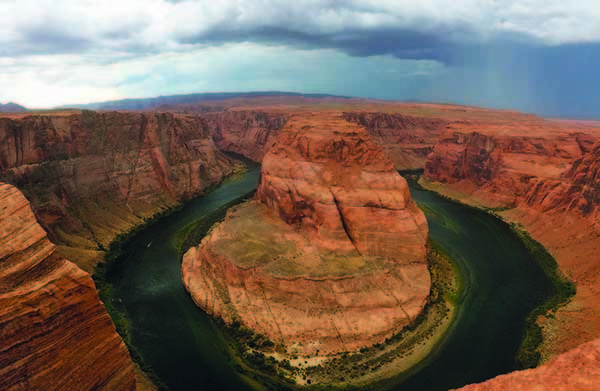
I figured Horseshoe Bend would give the kids an idea of what they missed. A curve of the Colorado River forms a 1,000-foot hole in the desert floor in the shape of a perfect horseshoe. The best part is that there aren’t any walls or fences. Just crawl to the edge at your own risk, especially when a sandstorm began whipping across the plain.
I told Maeve and Kate to pose for a picture by the ledge, but Laurel shot me the death look and suggested a 10-foot buffer. The vertigo was palpable. John’s hat blew off but luckily flew back from the cliff. Gazing down during our final stop, it was hard to gain perspective until a tiny boat zoomed around the bend. In her trip journal, Maeve called it “epic.”
It was time to head home. The kids had seen enough desert for one day. As we rolled through Monument Valley toward Moab, they watched a movie. I recalled the scene from Easy Rider where the movie’s stars ride motorcycles through the desert to the tune of “Born to be Wild.” I play the Steppenwolf song in my headphones and enjoy the views alone. It occurs to me that experiencing too much beauty too quickly can cause a person to become desensitized to it, just as too much violence can dehumanize.
The two-day trip back brings more blurs: hysterical screams of STOP!, the dubious phrase “I barely touched her.” Cooped inside, chaos peaking. Retreat into head and the next adventure. Sometimes planning is half the fun. About to explode, arrival just in time.
As we pulled into South Bend, I asked the kids which place they’d like to explore further: the mountains, the coast or the desert?
“I thought we saw everything there was to see,” Kate said.
Not even close, I replied. This trip was a sampler — all breadth and no depth. We surely saw some real mountains. In the future, we’d need to make more opportunities to plumb the primordial valleys and climb the ethereal peaks. We had traveled the right direction, but the trail beckons ahead for miles upon miles.
Brendan O’Shaughnessy works in communications for Notre Dame. A former teacher and Indianapolis Star journalist, he is the co-author of three Notre Dame books for children.
